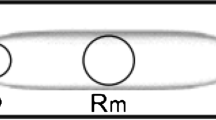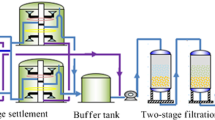After 43 years of water drive development, the DG oilfield reached the stage of high recovery and ultrahigh watercut. At present, the efficiency of enhanced oil recovery (EOR) technologies, namely waterflooding, in the DG oilfield and the stable production are low. To develop and evaluate a new EOR mode, we have performed pilot tests comparing the waterflooding technique and the weak-alkali alkali/surfactant/polymer (ASP) flooding. Based on the laboratory tests, the formulation of the weak-alkali ASP flooding system has been developed. The objective of the new EOR method is to maintain the stability of the system under reservoir conditions. In this paper, we focus on the factors influencing the effectiveness of the proposed weak-alkali ASP system, including sodium and potassium ion concentrations, calcium and magnesium ion concentrations, water quality, and the shear viscosity of the solution. The results show that, depending on water quality and the ion concentrations, the interfacial tension of the developed weak-alkali ASP system can be maintained at an ultralow level below 10–3 mN/m. The influence of sodium and magnesium ion concentrations is slightly higher than that of potassium and calcium ion concentrations, respectively. Considering the cost-effectiveness of the new system, it is recommended that the solution be diluted with clean water mixed with oilfield sewage, and the calcium and magnesium ions be removed from the solution before preparation. When the core permeability is 95·10–3 μm2, the pore throat size has little effect on the molecular weight and viscosity of the system after shearing.






Similar content being viewed by others
References
K. Wyatt, M. J. Pitts, and H. Surkalo, “Mature waterfloods renew oil production by alkaline-surfactant-polymer flooding,” SPE Eastern Regional Meeting, Lexington, Kentucky, USA (2002).
M. Pratar and M. S. Gauma, “Field implementation of alkaline-surfactant-polymer (ASP) flooding: a maiden effort in India,” SPE Asia Pacific Oil and Gas Conference and Exhibition, Perth, Australia (2004).
D. Wang and Y. Hao, “Results of two polymer flooding pilots in the central area of Daqing oil field,” SPE Annual Technical Conference and Exhibition, Houston, Texas, USA (1993).
D. Wang, Z. Zhang, J. Cheng, et al., “Pilot test of alkaline-surfactant-polymer flooding in Daqing Oilfield,” SPE Res. Eng., 12, 229-233 (1993).
C. Wang, B. Wang, X. Cao, et al., “Application and design of alkaline-surfactant-polymer system to close well spacing pilot Gudong Oilfield,” SPE Western Regional Meeting, Long Beach, California, USA (1997).
Z. Qu, Y. Zhang, X. Zhang, et al., “A successful ASP flooding pilot in Gudong Oilfield,” SPE/DOE Improved Oil Recovery Symposium, Tulsa, Oklahoma, USA (1998).
H. Gu, R. Yang, S. Guo, et al., “Study on reservoir engineering: ASP flooding pilot test in Karamay Oilfield,” SPE International Oil and Gas Conference and Exhibition in China, Beijing, China (1998).
D. Wang, J. Cheng, et al., “Summary of ASP pilots in Daqing Oilfield,” SPE Asia Pacific Improved Oil Recovery Conference, Kuala Lumpur, Malaysia (1999).
J. Vargo, J. Turner, et al., “Alkaline-surfactant-polymer flooding of the Cambridge Minnelusa Field,” SPE Rocky Mountain Regional Meeting, Gillette, Wyoming (1999).
J. Zhang, K. Wang, F. He, et al., “Ultimate evaluation of the alkali/polymer combination flooding pilot test in Xing Long Tai Oilfield,” SPE Asia Pacific Improved Oil Recovery Conference, Kuala Lumpur, Malaysia (1999).
Author information
Authors and Affiliations
Corresponding author
Additional information
Translated from Khimiya i Tekhnologiya Topliv i Masel, No. 4, pp. 116–121, July–August, 2021.
Rights and permissions
About this article
Cite this article
Liu, J., Zhang, K., Huang, L. et al. Research on Factors Influencing Weak Alkali Surfactant Polymer Flooding System. Chem Technol Fuels Oils 57, 724–731 (2021). https://doi.org/10.1007/s10553-021-01298-9
Published:
Issue Date:
DOI: https://doi.org/10.1007/s10553-021-01298-9




